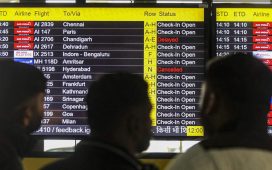Most of the changes, which are a couple of years away from being widely available in new cars, could make electric cars more competitive in price and performance with gasoline-powered models.
CATL — its full name is the Contemporary Amperex Technology Company Ltd. — produces a third of the world’s electric car batteries and supplies 16 of the world’s biggest carmakers, including General Motors and the Shanghai factory of Tesla. Its main rivals for the global market are BYD in Shenzhen, China, which makes about one-sixth of the world’s EV batteries, almost entirely for its own cars, and Korean and Japanese battery manufacturers.
CATL executives spoke at a news conference before the Shanghai auto show, which starts Wednesday. The choreographed event evoked the launch of a new car model.
Batteries represent at least a third of the cost of an electric car, making CATL a critical player in the EV supply chain in China and beyond. Many automakers have been watching nervously whether CATL will someday try to establish its own car brand that could overshadow their own models.
The biggest surprise by CATL was an announcement about auxiliary batteries for electric cars. The batteries would share space in the underbody of cars, where there is currently only one large battery. The auxiliary battery would be the first commercially available electric vehicle battery that would not use graphite as one of its poles, CATL said. Removing costly graphite will eventually make the batteries cheaper, after some initial costs, and will allow 60% more electricity to be squeezed in each cubic inch of the battery, said Gao Huan, CATL’s chief technology officer for electric cars in China. The extra energy density means that the car’s driving range can be greater, or the overall size of the battery can be reduced, leaving more room for the car’s passenger compartment.
The second battery also would provide backup in case one has trouble. That has become more important as self-driving features, which require uninterrupted electricity, become more common.
Ouyang Chuying, co-president for research and development at CATL, said that auxiliary batteries without graphite would be available in cars in two to three years and possibly sooner. He declined to say which automakers might be the first to use them.
But taking out the graphite has a downside, which is why CATL will only remove it for the auxiliary batteries. Batteries without graphite recharge more slowly, and cannot be recharged as many times as conventional EV batteries before they need to be replaced.
The auxiliary batteries are meant to be used less frequently, on longer drives after the main battery is exhausted.
CATL, which is based in Ningde, China, also said it had made more progress in the speed of charging main batteries. The company said its new system would allow an electric vehicle to be charged enough in five minutes to drive 520 kilometers, or 320 miles.
BYD and Huawei, a Chinese electronics giant that plays an ever-larger role in auto parts manufacturing, have also announced five-minute charging systems, known as supercharging.
CATL also said it would start selling sodium-ion batteries, which can retain more than 90% of their charge even at a temperature of 40 degrees below zero, for use in cars and trucks with internal combustion engines. The sodium batteries could be used by automakers to replace conventional lead-acid batteries, which go dead in very cold weather, and in some electric cars.
Ouyang said that the electricity of these sodium batteries would be compatible with the electrical systems of existing gasoline-powered cars, but the new batteries might not fit in the same space.
CATL said that its first customer for sodium-ion batteries would be freight trucks from First Auto Works, an automaker in Changchun, in China’s far northeast, where temperatures frequently fall well below zero. Developing sodium-ion batteries has been a priority for the Chinese electric car industry because the country’s northern provinces, bordering Mongolia and Russia’s Siberia, have bitterly cold temperatures in winter.
In interviews last autumn, car owners in Urumqi, in the far northwest of China, drivers said that cold weather was why they would not consider buying electric cars.
Battery makers have been working on sodium-ion batteries for many years, but the United States may have a long-term advantage in the technology. Almost all of the world’s naturally occurring geological deposits of soda ash, the raw material for sodium-ion batteries, are in southwestern Wyoming.
CATL showed a video of its sodium-ion batteries undergoing stress tests, such as being punctured with a nail or power drill or even cut in half with a power saw, without catching fire or exploding. Just five years ago, CATL had argued that nail tests were unrealistic and batteries should not be expected to withstand them.













